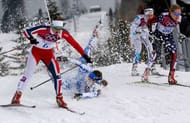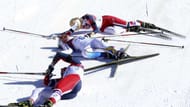5. Ice Hockey

Imagine a goalpost as an atom, with electrons whirring and buzzing about and banging into each other. That's ice hockey in a nutshell. A blazingly fast sport which taxes the aerobic and anaerobic systems to the limit and beyond, ice hockey is a relentless grind in the guise of a pleasant skating sport.
One of the primary causes of fatigue in sports is the incessant pounding of the legs on hard ground. Ice hockey looks easy because the players seem to glide effortlessly on skates. Here's a fun fact though: ice hockey is so tiring that even the best players barely play half of the game.
In the NBA, superstars generally play around 36 minutes per game for 75% of the total duration of 48 minutes of a match. In football, a superstar player often plays the entire duration of a contest. Contrasting this with the NHL, the games are 60 minutes long and divided into three 20-minute periods. And yet, the league leader in minutes per game averaged just 28 minutes and 48 seconds per game in the 2015 season.
That's less than half of the total duration. The players in ice hockey are often substituted every 60-90 seconds to stay fresh. Even in the final of the Stanley Cup in 2015, no player from either team could muster 30 minutes on the ice.
There are only six players in each team, but 20 players in total are allowed to dress for a game. Injuries are also a huge part of the sport. It is very common to witness sprains, fractures, bruises and contusions in ice hockey.
To understand why ice hockey players get so tired, you have to take an in-depth look at the demands exacted by the sport. For the most part it involves running sprints at full speed while being weighed down by full body gear and being pole-axed and shoulder-checked by your opponents.
If you had to think of the most exhausting activity on a per-minute basis, the answer would be simple: sprint for a healthy distance, stop, and sprint again ad nauseum. The main reason ice hockey is so tiring is quite simple: the constant speed required.
Usain Bolt's top speed is 44.64 km/hr. In football, Antonio Valencia is the fastest player among the currently active footballers with a top speed of 35.2 km/hr. In ice hockey, there are numerous players who have recorded a top speed above 35 km/hr.
Now take Valencia's top speed, put him in an arena with 11 other athletes, hand them all long sticks and permit them to smash into each other. There you have a perfect model for chaotic, and utterly exhausting, destruction.
It takes tremendous force to constantly decelerate and accelerate at those speeds. Moreover, when a team has possession of the ball in football or basketball, the opponents give them some space and settle back to defend. But in ice hockey, the defenders are always poking, jabbing and elbowing their way to the puck.
Calories burnt per minute: 12.52
Sweat loss per minute: 0.04 litres
Duration: 60 minutes
4. Cross country skiing
We are accustomed to judging the level of exhaustion of any activity by seeing the drops of sweat dripping from a person. And winter sports by their very nature prevent that sight.
Skiing looks like a fun and relaxed activity. It seems that all you have to do is gather momentum, and it’s all smooth sailing after that. Skiers exude majestic poise as they carve through the snow, painting a serene picture fit for any canvas.
But that illusion is shattered when you watch skiers approach the end of any cross country race. As you see them collapse like boneless rag-dolls at the finish line, you struggle to make sense of it all.
Take a look at the women's 15-kilometre skiathlon at the 2014 Sochi Olympics. The top three finishers – Marit Bjoergen, Charlotte Kalla, and Heidi Weng – all collapsed across the finish line, looking like they had been shot. You'd be forgiven for glancing at potential vantage points for snipers.
Cross-country skiing at the Winter Olympics features a distance of 50 km as the longest race. While the body is spared the direct pounding on concrete (like in running), there is no respite in the stream of non-stop strokes you have to extract out of your body.
American cross country skier Kikkan Randall says, “Skiing is pushing yourself so close to those physical limits and you’re really just convincing yourself to last for incremental times longer.”
Skiing is difficult enough to begin with because of the frigid temperatures it’s practised in. You don't get any help from gravity either, like you do in running. It's a constant grind, using the upper and lower body to carve a path through the unforgiving snow. Skiers also have to get low in a crouching position to minimize drag, which adds additional strain on the core.
If running is like bouncing, skiing is a fast crawl. All the major muscle groups are utilized, and you have little to no opportunity to relax.
Picture squeezing an orange till all the juice is drained, then grind the remnants to extract the few extra drops, then pound the remains into a paste to cajole out another precious drop. That's how it feels to take on cross country skiing, where you are the orange.
Dr. Heil, who has studied cross-country skiers closely, talks about the sport thus: “Repeated high intensity anaerobic efforts will cause a quick build-up of acid by-products in the muscles, which causes the muscles to stop contracting effectively. In short, you combine an insatiable need to breathe as hard as possible with leg and arm muscles seizing from acid build-up, along with a central nervous system unable to control the act of standing and gliding upright, and the result is skiers dropping to the ground because they cannot stand and they need to recover.”
The lactic acid build-up makes your limbs feel like they're made of lead. And the fatigue creeps in within the first few minutes of the races, making the entire exercise an upward climb of gigantic proportions.
Calories burnt per minute: 16.42
Sweat loss per minute: 0.025 litres
Duration: 160 minutes
3. Marathon
“I’m a cripple,” said Lance Armstrong after finishing his first marathon.
Armstrong's stamina is the stuff of legend, even more so now that we know he was enhancing his performance by doping. He ran his first full marathon in 2007, and here's what he had to say after it:
“I can tell you, 20 years of pro sports, endurance sports, from triathlons to cycling, all of the Tours — even the worst days on the Tours — nothing was as hard as that, and nothing left me feeling the way I feel now, in terms of just sheer fatigue and soreness,” he said.
This was Armstrong’s first marathon, and he said that running the 26.2-mile distance, particularly the final eight miles, was the “hardest physical thing” he had ever done.
The origin of the marathon itself puts its difficulty into perspective. Legend has it that Philippides ran non-stop from the battlefield of Marathon towards Athens, to announce the victory of the Greeks over the Persians.
"Joy to you! We've won!" were the first words of Philippides after reaching Athens. He murmured "We won, we won!" a few more times, before collapsing in a heap and passing away from exhaustion.
Let that sink in. The man whose run inspired the punishing 42.195 km race, breathed his last at the finish line because of the demands exacted by the run. This raises the question: what kind of sadist would design an event based on the death of its first participant?
Whisper the words 'Hit the Wall' to a marathon runner, and watch him or her retreat into a corner to curl up and sob. Strong men and women who may laugh through screenings of The Conjuring in a graveyard will shake and quiver in their boots at the mention of The Wall.
There are few physical activities as punishing as running a full marathon. The distance of 42.195 kilometres looks daunting in itself, but you truly grasp its magnitude when you cross the 30 km mark. That is when you 'hit the wall'.
The Wall is something which comes around in a marathon at about the 31-km mark. Hitting the wall signifies the depletion of glycogen reserves in the muscles and the liver. That means the tank of your body's conventional energy reserves has run empty, and the body needs to start resorting to solely burning fat to continue.
I've completed three full 42.195 km marathons myself, with my best timing being 3:31 in the Mumbai Marathon in 2012. That is faster than the times recorded by world class athletes Edwin van der Sar and Pavel Nedved – which goes to show how unique the demands of marathon running are.
A marathon is an incredibly deceptive event. You start off merrily unaware of the trials and tribulations that lie ahead. By the 10-km mark, you're wondering what the big deal about a marathon is, since you're happily chugging along with your fuel tank heavy. By the 20-km mark, you wonder how it is that it’s only been that far, since you've certainly covered a lot more. You start to view the mile markers with distrust and disgust, and begin hoping that the mistake of labelling the 30-km mark as the 20 will soon be rectified.
At the 32-km mark, the leg muscles give notice, ceasing to respond.That's when you start to power yourself by swinging your arms, as your legs feel like dead weight. There is neuromuscular fatigue as well, and all you can think about is your stupidity in choosing to willingly undergo such an ordeal, while also knowing that you don’t want this to be the last marathon you run.
Five kilometres from the finish line, there is nothing more to give. You try to lean forward more than usual to let gravity assist your pitiful movement, and pray to the gods you never acknowledged before to fashion some miracle and bring the tape close to you.
The ordeal isn’t over after crossing the finish line. Blisters and corns greet you with enthusiasm, ankles feel immobile and burn at every flexion, thighs and calves are laden down with rock salt, and your entire torso feels like it’s been steamrolled.
Calories burnt per minute: 17.15
Sweat loss per minute: 0.04 litres
Duration: 180 minutes
What is the foot injury that has troubled Rafael Nadal over the years? Check here




